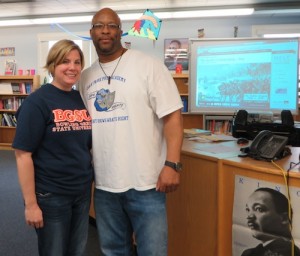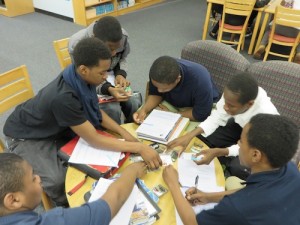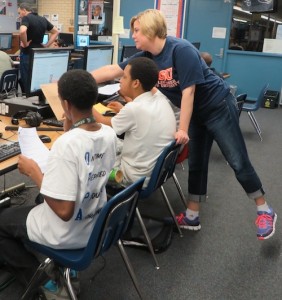Lisa Kraiza and her collaborator, Doug Eiland, were part of a year-long interdisciplinary curriculum writing initiative at Oakland Schools focused on research writing. Explore their interdisciplinary unit about the Civil War and the other completed units from the initiative.
***

Lisa Kraiza & Doug Eiland, 8th grade teachers at Oak Park Prepratory Academy
The conversation went a little like this:
“Doug, would you like to write an ELA/Social Studies unit together?”
“Sure, what topic should we do?”
“You pick. I can make ELA work into anything.”
“How about the American Civil War? The kids really seemed into the brother against brother concept of the event.”
“Great! I can work with that…”
Uh, wait a second, I later thought to myself, I only know the bare bones of the Civil War. And so it began, the great American journey into cross-curricular unit writing. (I would like to thank my brother-in-arms, Douglass Eiland, for taking a risk and jumping feet first into this adventure. Our students are lucky to have him as their social studies teacher and a role model.)
Doug and I had this conversation in September of 2013. We piloted our finished unit in April of 2014. We decided we wanted the outcome of this unit to be: students can see the connection between two disciplines when learning about a topic and understand the broader scope of the Civil War not as just a bunch of battles that happened a long time ago, but as a period in American history that still has repercussions for us today. This looked great on paper, but there was one major problem. I, the ELA teacher, barely knew a speck about the Civil War. I needed to learn as much as I could so I could feel comfortable teaching my students during this cross-curricular unit. I had to quickly immerse myself in this time period. And oh boy, did I ever!
We decided that the essential question underpinning the unit would be: what does it take to survive civil war? Once we had gathered all the information and resources we thought students would need, the question became — what do we do with all this? How would we remain in this cross-curricular mindset and capture the minds of the students? The answer: student learning centers. There is so much to learn and know about the Civil War that it could prove overwhelming for both us as teachers and for the students. So our plan was to introduce the Civil War in a joint teaching session that involved student learning centers. We broke the Civil War material down by type of media, resulting in seven different learning centers:
- Trade Books
- Photography
- Poetry
- Film
- Trading Cards
- Political Cartoons
- Writing

students learning collaboratively at a learning center
There was a task to complete at each center and students had a recording sheet (click here to see an example). They would receive a grade in both social studies and ELA for their work. At the end of the two-day session, students completed an exit ticket to reflect on their introduction to the Civil War. It was thrilling to see students so engaged and curious. We received many tickets with “a-has” and “this makes sense.” After Doug and I high fived each other, we went into our classrooms to answer the students’ questions with our respective lessons.
So now what? How would Doug and I come together to summatively assess what the students would learn in this unit? The answer came in the form of a multimedia presentation on a Civil War personality. Each student was assigned a person on day one of our unit. These figures from the Civil War came from all walks of life, famous, infamous or long-forgotten. We had a balance of Northerners, Southerners, military personnel, and folks on the home front. Students were to present to their peers a study of how their person survived, or did not survive, the Civil War.
We allowed for joint research time, supported students in finding and using sources, and encouraged collaboration. Students presented to both their ELA and social studies classes and again received double credit. We had some amazing presentations! Students became their Civil War personas. They connected to the war on an emotional level and were able to see that that choices these historical figures made were not as simple as they had once believed. We saw increased pride and motivation in our students to do a good job. This wasn’t always the case with traditional “final” projects. Lastly, students developed a clear vision of how social studies and ELA can live together in their minds. There were many light bulb moments for our students.
 This experience showed me and Doug that it is imperative for disciplines to collaborate. Neither of us could have gotten the quality of work the students produced had we done this separately. For the first time, students were seeing exactly how the skills they learn in their individual classes apply to all classes. They were developing skills–research skills, presentation skills– not just memorizing facts and figures.
This experience showed me and Doug that it is imperative for disciplines to collaborate. Neither of us could have gotten the quality of work the students produced had we done this separately. For the first time, students were seeing exactly how the skills they learn in their individual classes apply to all classes. They were developing skills–research skills, presentation skills– not just memorizing facts and figures.
And we learned that it is okay to have students see their teachers try new things. It is okay to “share the spotlight” and lean on other educators to fill in gaps for us. True collaboration is honoring what the other person brings to the table, and Doug and I feel that we 100% honor each other as professional educators. Of course, there are many small items that we will change or revisit in this unit, but the overall meaning and intention of the unit was met with vigor and enthusiasm.
Let the Union prevail and in the words of the great Abraham Lincoln:
“Always bear in mind that your own resolution to succeed is more important than any other one thing.”
 Lisa Kraiza teachers eighth grade English Language Arts at Oak Park Preparatory Academy. She is also a member of the Core Leadership Team of the Oakland Writing Project.
Lisa Kraiza teachers eighth grade English Language Arts at Oak Park Preparatory Academy. She is also a member of the Core Leadership Team of the Oakland Writing Project.
